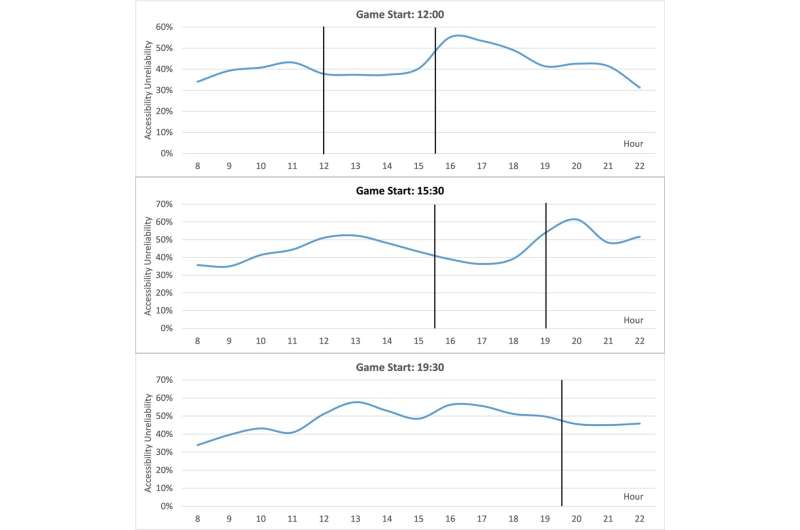This article has been reviewed according to Science X's editorial process and policies. Editors have highlighted the following attributes while ensuring the content's credibility:
fact-checked
peer-reviewed publication
trusted source
proofread
Study uses new tech to observe how big events can disrupt public transit over an entire city

New technology has allowed scientists to see how a major sporting event can disrupt public transportation in an entire city for hours before and after the event.
Researchers conducted a case study in Columbus on days that Ohio State University had home football games, attracting more than 100,000 fans to Ohio Stadium on the university's campus.
Findings showed that bus service across the entire city was significantly less reliable for more than 7 hours on game days than on other days, meaning that even bus riders who were not traveling near the university could not get to their destinations in times promised by the schedule.
"Most people in Columbus know that you don't go near Ohio Stadium during on football Saturdays because traffic is going to be a nightmare," said Harvey Miller, co-author of the study and professor of geography at Ohio State.
"But the remarkable thing to me is that, if you're a bus rider, you didn't have to be anywhere near the stadium to be affected by the game."
The study was led by Luyu Liu while he was a Ph.D. student at Ohio State and was published recently in the Journal of Transport Geography.
The researchers examined bus service provided by the Central Ohio Transit Authority (COTA), the city's public transit system. It serves an area with more than 1.2 million residents and generated 19 million trips in 2019.
The primary data source for the study is General Transit Feed Specification data. It is the source of real-time data on bus services that transit apps use to help commuters plan their trips.
The study compared bus service on the 13 days Ohio State had home football games in 2018 and 2019 with days the Buckeyes had away games and on other days when there were no games.
Liu, who is now a postdoctoral researcher at the University of Florida, said transit disruptions before and after the games were different.
"The disruptions before the game lasted longer but were not as severe, while after-game impacts have shorter duration but were more disruptive," Liu said.
That's probably because people arrive at games over an extended period, but nearly all leave right after the game ends.
Results showed that the unreliability of the bus serve was 8.7% higher than average at the before-game peak but 24.5% higher at the after-game peak.
The time between the peaks, when the football game had the most impact on transit reliability, was about 7 hours.
But this period between the peaks was just the "core of the disruption," the researchers said. Transit service was still affected at least somewhat before and after this 7-hour period.
While this study examined the impact of a football game on bus service, the measures developed by the researchers could be used to analyze any kind of disruption to regular traffic flow and extend well beyond just effects on public transit.
The results could apply to crashes on an interstate, a bridge collapse, construction delays, any large event, and a variety of other situations.
"We found that these disruptions can propagate through the entire transportation system in a city very easily," said Miller, who is director of Ohio State's Center for Urban and Regional Analysis.
But with these tools, city transportation planners can prepare in advance.
"We now have the ability to look at what parts of a city's transportation system are most vulnerable to disruption," Miller said.
"We could see if a disruption at one particular place would most likely stay localized or whether it will spread out and have a big system-wide impact."
Public transit is not subject to only short-term disruptions. The researchers also looked at the impact of the COVID-19 pandemic on longer-term public transit accessibility in Columbus.
The findings showed mixed results. Reliability actually increased soon after lockdowns were instituted in Ohio in March 2020 as overall traffic declined, allowing buses to move more freely.
But that changed in May 2020 when the transit authority made major schedule changes to adapt to plunging ridership and financial difficulties.
The downtown area, which accounts for the most ridership in the system and experienced the fewest service cuts, had less loss of accessibility and reliability, said Liu. Not all areas of the city fared so well.
"Some parts of the city, particularly the northeast area, have still not recovered their service levels from before the pandemic," he said.
"That's bad news for people who rely on public transit to get to their jobs, medical appointments, and shopping."
The researchers said they hope these findings lead officials to find ways to build and improve infrastructure for public transit.
"With climate change, pandemics, and other disruptions, transit systems are only going to find more challenges to keeping their services reliable and accessible," Miller said.
"Planning for these disruptions should be a major focus."
More information: Luyu Liu et al, Measuring the impacts of disruptions on public transit accessibility and reliability, Journal of Transport Geography (2023). DOI: 10.1016/j.jtrangeo.2023.103769




















